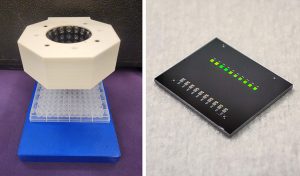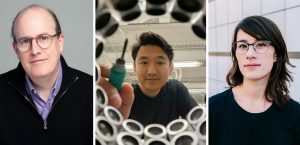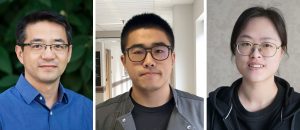
Above, at left, Levity Technologies’ robotic liquid mixing system prototype, which is designed to help labs, biotech firms and pharmaceutical companies increase chemistry process yield. On the right, Quantum Beam’s acousto-optic beam steering chip prototype. This novel steering technology for chip-based LiDAR systems is compact and low cost to manufacture.
Two UW ECE-led research teams have been named CoMotion Innovation Gap Fund Award recipients for fall quarter 2022. Each team received $50K in support funding (the maximum possible award), alongside six other research teams from across the University. The award announcement was posted on the CoMotion website in early January. CoMotion handles technology transfer at the UW, providing valuable tools, connections and guidance for faculty and students that helps to transform ideas into economic and societal impact.
The CoMotion Innovation Gap Fund has been helping UW research teams for more than a decade. It provides over $1.1 million annually in awards of up to $50K to UW project teams. The Gap Fund aims to support projects and technologies that have a high chance of making an impact but have a need for funding the “gap” — the transition between the conclusion of academic research grants and achieving a level of development that can attract seed-stage private investment.
Learn more about team members and their respective projects below.
Levity Technologies: Contactless Robotics and Automation for Synthetic Biology

Levity Technologies’ research team members (from left to right) UW ECE Professor Joshua Smith, fifth-year doctoral student Jared Nakahara, HCDE Assistant Professor Nadya Peek
Levity Technologies is led by Joshua Smith, who is the Milton and Delia Zeutschel Professor in Entrepreneurial Excellence at UW ECE and in the Paul G. Allen School of Computer Science & Engineering. His research team includes Nadya Peek, an assistant professor in the Human Centered Design & Engineering department at the UW, and Jared Nakahara, a fifth-year doctoral student at UW ECE.
Levity seeks to address current mixing technologies used by biology labs that rely on manual and robotic physical-based methods. Sample loss and poor mixing result in low quality yields and inaccurate results. The Levity robotic liquid mixing system helps academic labs, biotechnology firms and pharmaceutical companies increase their chemistry process yield by thoroughly mixing reactants together and preventing the loss of costly sample material. Levity uses cutting-edge acoustic levitation systems to perform non-contact sample mixing and containment.
“We are grateful to receive this grant from the CoMotion Innovation Gap Fund,” Nakahara said. “The funding will allow Levity to bridge the gap between research technology and a commercial system.”
Quantum Beam: Chip-scale Light Detection and Ranging (LiDAR)

Quantum Beam research team members (from left to right): UW ECE Professor and Associate Chair for Research Mo Li, Postdoctoral Scholar Bingzhao Li, graduate student Qixuan Lin
Quantum Beam is led by UW ECE Professor and Associate Chair for Research Mo Li. Team members include Postdoctoral Scholar Bingzhao Li and graduate student Qixuan Lin. The team has also received a Washington Research Foundation Technology Commercialization Phase-1 grant of $100K to support their work, in addition to the Gap Fund grant.
LiDAR is a high-resolution 3D-imaging technology used for many machine vision applications. It relies on mechanical scanners, which are bulky, fragile, and expensive, preventing greater adoption of LiDAR across the marketplace. Quantum Beam innovates a novel acousto-optic beam steering technology for chip-based LiDAR systems that is compact and low cost to manufacture, which opens up many new, potential applications for the technology in a wide range of areas, such as autonomous vehicles and robotics.
“We’re grateful for and excited to receive this grant from CoMotion because it provides the first seed fund for us to explore the commercialization possibility of our cutting-edge research,” Li said. “We will use the fund to develop the first prototype, investigate the best use-case and discover potential customers.”
More information about all CoMotion Innovation Gap Fund Awardees is available on the CoMotion website.

